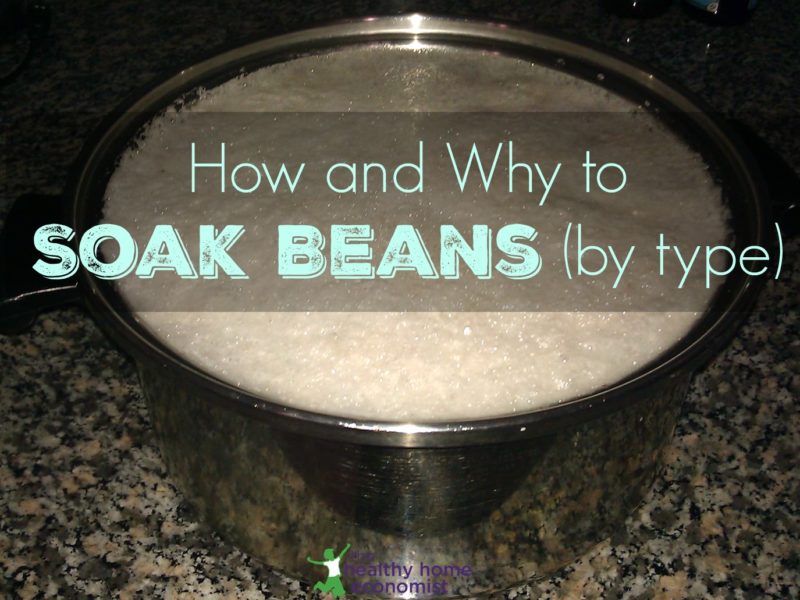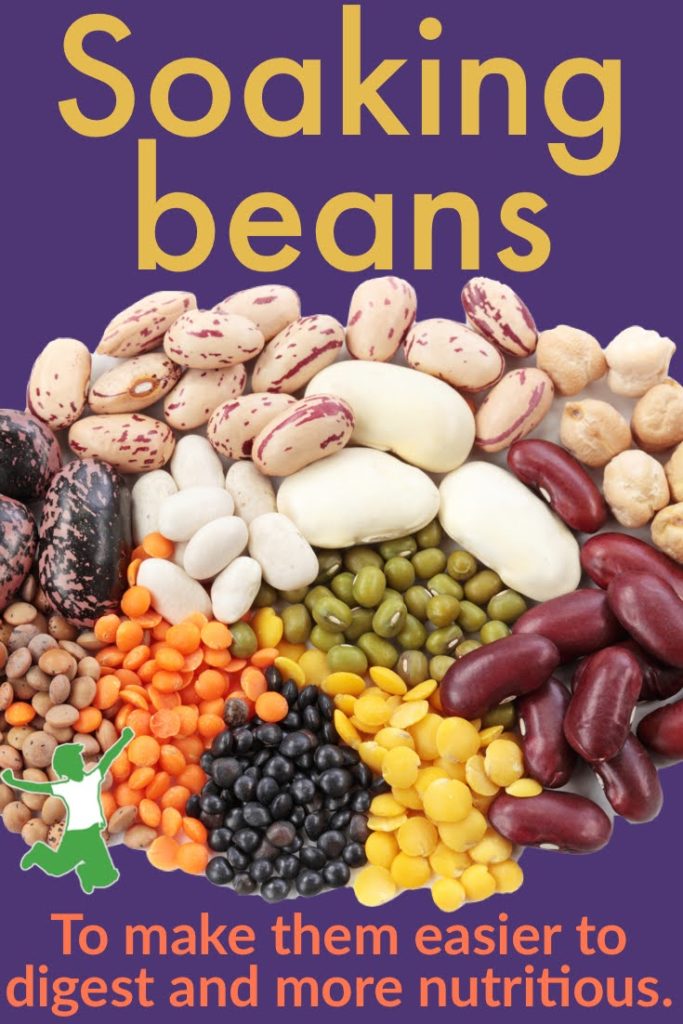Table of Contents[Hide][Show]
The simple overnight process of how to soak beans (by type) will help to eliminate gas and intestinal issues so you can enjoy eating these nutritious plant foods again!

I went on a bean soaking binge this past weekend, and the amount of scum that came to the top of the large pot of soaking kidney beans was so huge, I thought it deserved its own blog post. Soaking beans for many hours before cooking them produces a lot of scum which is course, is rinsed and drained away when the soaking is complete.
What is all that scum anyway? Anti-nutrients, that’s what! And those anti-nutrients such as phytic acid, lectins, and enzyme inhibitors are going to be in your gut causing you gas, heartburn, reflux, and whatever other digestive ills beset you when you eat something that isn’t particularly digestible unless you soak your beans before cooking them.
Traditional cultures took great care to prepare their legumes with a long soak before cooking to enhance digestibility and nutrient absorption.
I love Mexican food but really try to avoid Mexican restaurants for this reason .. they don’t soak their beans before cooking them!
After a meal at a Mexican restaurant, I will typically feel very bloated. Eating the same meal prepared at home where I soaked the beans properly before cooking results in no digestive upset whatsoever.
Take the Soaked Beans Challenge!
If you think unsoaked beans don’t cause you any trouble .. take this challenge. Soak beans next time before cooking and notice the difference in your stomach after eating.
You may think that the unsoaked beans don’t cause you any trouble, but you just may find that soaked beans are infinitely more filling and that you eat less and enjoy the meal more as a result!
Traditional peoples were very wise in the preparation of their foods. They not only selected nutritious foods but they prepared them for maximum digestibility and nutrition.
What good is eating nutritious legumes if the body is so whacked by the anti-nutrients that it can’t very easily extract and digest the nutrition?
So, the next time you make your beans, make sure you soak them first!
I soak large pots of various types of beans every month or so and then cook them – freezing for easy, quick meals when beans are required like homemade chili.
**If you absolutely do not have time to do this, at least buy pre-soaked legumes and beans packed in glass jars. Your digestion will thank you!
How To Prepare Beans by Soaking (video tutorial)
If you’ve never soaked beans before, it’s so easy. It’s a very similar process to soaking nuts. The method also mimics the wisdom of traditional societies that soaked seeds.
See this short video below that demonstrates the simple process.
Kidney shaped beans
For kidney shaped beans and dried/split peas, put a pinch of baking soda and enough water to cover in a large pot and soak uncovered for 12-24 hours. Drain, rinse and cook as usual.
Examples of kidney-shaped beans include:
- Red kidney beans
- White kidney beans (cannellini beans)
- Pinto beans
- Anasazi beans
- Black-eyed beans (black-eyed peas)
- Great Northern beans
- Lima beans
Non-kidney shaped beans (and other legumes)
For more oval-shaped beans and other legumes, soak for 12-24 hours in filtered water to cover plus 1 tablespoon of cider vinegar or lemon juice for every cup of dried beans/legumes used.
A homemade apple cider vinegar recipe or store-bought are both fine (make sure the ACV is packed in glass). Liquid whey from yogurt, kefir, or clabbered milk may also be used. Drain, rinse, and cook as usual.
Examples of non-kidney shaped beans include:
- Black beans (turtle beans)
- Navy beans
- Fava beans
- Adzuki beans
- Chickpeas
- Lentils
For maximum digestibility, it is best to rinse and refresh the filtered water and baking soda or the acidic medium once or twice during the soaking period. If you forget, no worries.
I try to always soak beans for the full 24 hours instead of just overnight. Sometimes if I get busy, I might even soak them 36 hours, but this is risky as they can get moldy sometimes if you go over 24 hours. Best to stay between 12-24 hours particularly during summer months.
How to Cook Beans After Soaking
After soaking, be sure to thoroughly drain and rinse the beans until all the scum is washed away. Then, complete the process by doing the following.
- Fill the pot of rinsed pre-soaked beans with fresh filtered water, bring to a boil, and skim away any additional foam that may come to the top at the start of the boil.
- Turn down the heat to a simmer, add 4 crushed garlic cloves, and cook until the beans are soft (about 4 hours).
- Drain beans and add to your favorite dish or let cool and freeze in large freezer bags for quick meals at a later date!
You won’t be needing over-the-counter gas meds after preparing beans the traditional way!
Should You Use the Soaking or Cooking Water?
Some alternative cooking circles advocate using the soaking or bean cooking water. Unfortunately, neither of these practices is traditional.
Using the cooked bean water or aquafaba is actually a dangerous practice. See the linked article for reasons to avoid this modern food especially during pregnancy!
Other Types of Legumes
This article plus video on soaking lentils provide additional information specifically for this legume. Because they are soaked exactly the same as all non-kidney shaped beans, it is helpful for visual learners.
Lentils were the favorite of nutritional pioneer Dr. Weston A. Price due to their very high potassium content.
Recipes Using Pre-soaked Beans and Legumes
Here are some recipes to try using soaked beans and other legumes to entice you!









Soaking in acid is NOT enough.
Suggestions for realllly hard water? Tough beans and a sore tummy…
Anyway, I’d rather the benefits of soaking them….but it sure would be nice to keep that flavor too! =)
My soaked (in water only) beans are delicious, but every time I’ve soaked them using whey, the beans had no taste at all! I am from the south where beans (especially pinto beans) were a staple poor folks’ food in my growing up years – they were cheap and we ate a lot of them. We never had gas problems either! I’ve heard that when you eat them often enough your body adjusts somehow. Anyhow, I stopped soaking my beans in acidic water because of the resulting blandness.
As for sprouting, I soaked (in plain water), then drained and sprouted some chick peas (garbanzos) recently and they were the best chickpeas I EVER had! The skin on the beans was tender, the beans soft and very flavorful. I just cooked them with some coconut oil and salt. And another thing about seasoning beans with salt – I keep hearing about not salting until the beans are partially cooked, but I’ve always added my salt at the beginning of cook time and never have any problems. In fact, if I wait too long to salt them, it seems that the beans just don’t take the salt–they don’t taste salted.
I love beans and I want them to be nutritious, but not at the risk of good taste. We always just ate straight beans, seasoned only with salt and a little fat of some kind. If they’re bland you have to add herbs and seasonings and other things to try to add some flavor. Not me, I want the flavor of the bean. With nutrition if possible. Sigh . . .
Naomi,
Do you follow the 12 hour rules noted above to get them to sprout? And then how long do you cook them?
I never soak my beans because I feel like they’ll be less flavorfull soaking up water rather than the seasoned water. What about soaking them, letting them dry out again, then cooking them? Will they spoil if you do that?
I meant could not get them to sprout.
Don’t you have to soak them and then drain them/just keep them moist to get them to sprout? I did not think they would sprout covered in water. When I sprout my wheat, I soak and then drain and keep moist and they sprout by the end of the day usually.
Yup- to sprout, you generally soak for about 12 hours (just plain water), then drain and keep damp, but ventilated. Rinse and drain every twelve hours until they’re sufficiently sprouted. According to SproutPeople.com, black beans are notorious for not sprouting well. According to them, even in good sprouting seed, you should only expect about a 50% turn out.
I read somewhere that black beans shouldn’t be sprouted for eating, but upon looking further, it seems that that’s only if you plan to eat them raw.
Actually, I used black beans (ones that I grew.) Nothing.
Sarah, what are you thoughts on fermenting beans? Overkill?
On another subject, how do you get posts from your facebook to show up here?
Sarah, I soak for 24 hours but I heard that fermented beans were the best for you. I tried soaking black beans for 36 hours, changing the water every 12. Nothing happened. I could get them to grow sprouts. (I followed the directions to cover the beans with water.) Is this true about fermenting beans?
Also, I cook my beans in a pressure cooker with kombu. I also avoid kidney beans and use adzuki’s (small red beans) instead since they are easier for me to digest.
If you are lactose intolerant can you use whey?
Raw whey is probably fine even if you are lactose intolerant. Apple cider vinegar or lemon juice works fine too. If you soak with just water, you may not get much scum at all when you soak.
Soak believer here.
My mother always soaked her beans. Said it would make you toot less. She always thought low fat dairy products and margarine were poison too. Smart mama.
I usually soak mine for at least 12 hours, but have read that you should for at least 48 hours. Are there more benefits to soaking for a longer time?
I have found that a longer soak does tend to reduce and gas from the beans should you eat a lot. I like to put tons of beans in my chili, so I opt for a longer soak.
I always soak my beans like that as well, and ive never had scum like that! I cook mine in the crockpot all day.
Some beans produce more scum than others! 🙂